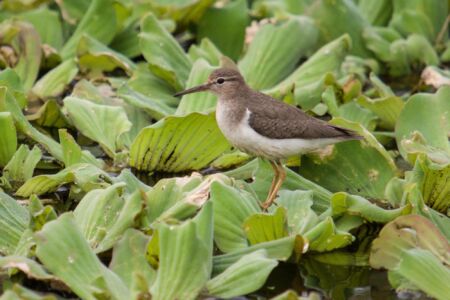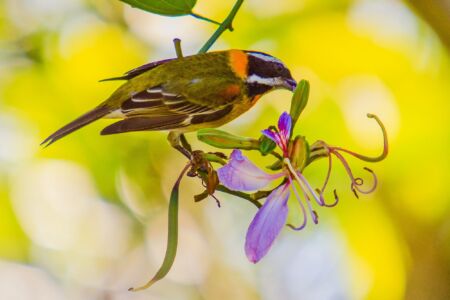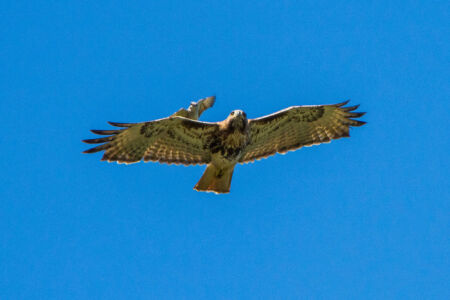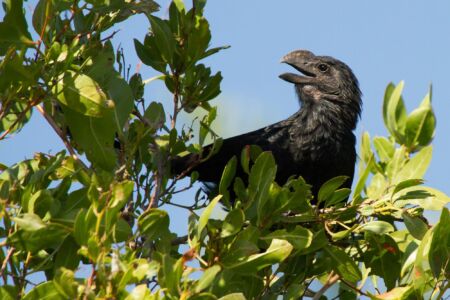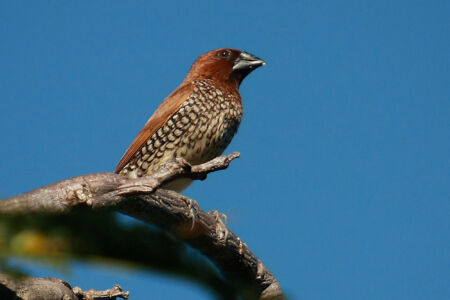FRIENDLY BIRDS & BREWS TOUR
PUERTO RICO [PRIVATE]: BIRDING THE ENCHANTED ISLAND

TOUR FOCUS
BIRDS & WILDLIFE
SCHEDULED TOURS
TRIP LEADERS
TOUR COST
From: $3,150 (See details)
Cost is per person, double occupancy from San Juan (SJU)
GROUP SIZE
6 - 13 Participants
AVAILABILITY
4 spaces available
PRIVATE TOUR OPTION
This tour is available as a private trip for any size group. The tour cost will vary with the number of people and any custom requests.
TESTIMONIALS
Highlights of PUERTO RICO [PRIVATE]: BIRDING THE ENCHANTED ISLAND
Description of PUERTO RICO [PRIVATE]: BIRDING THE ENCHANTED ISLAND
This fun and easy exploration of Puerto Rico’s prime birding locations will target the nation’s endemics and specialties. We’ll seek all 17 endemics in 7-days/6-nights of birding, plus a whole list of Caribbean specialties! Some of these specialties are being considered as possible future endemic species according to some researchers.
Many of the species we will seek are threatened or endangered… and in the case of the Puerto Rican Parrot, there are very few left. During our trip we will explore a variety of habitats from the northern Atlantic coast to the forests of ‘haystack hills’ in the west, to the southwest coast and dry forests along the Caribbean Sea, the central mountain rainforest and the eastern coastal region.
Length of Tour
7-Days/6-Nights
Brief Itinerary
Day 1 – Arrival in San Juan
Day 2 – North Central (BLD)
Day 3 – Rio Abajo – North Central (BLD)
Day 4 – Maricao – Southwest (BLD)
Day 5 – Cabo Rojo – Biobay (BLD)
Day 6 – Cartagena Lagoon – Plain Pigeon (BLD)
Day 7 – Flights Home (B)
(BLD = Breakfast, Lunch Dinner included)
Detailed Itinerary
DAY 1 – ARRIVAL IN SAN JUAN
Arrive at anytime today for your night in San Juan. (No meals included today.)
HOTEL: Airport Hotel
DAY 2 – NORTH-CENTRAL KARST REGION
Today we’ll bird the Northern Karst region, driving from San Juan and stopping along the way to look for Puerto Rican endemics plus many Caribbean specialties.
Karst, a landscape characterized by eroded limestone, covers more than one third of the island’s territory. The Northern Karst is located primarily in the subtropical moist forest life zone. The karst region originated in a marine environment, as many as 140 million years ago. Geological processes have created spectacular landforms, such as the haystack hills, or mogotes, which are unique formations within the United States. Due to its rugged topography the karst region of Puerto Rico holds the most extensive forest canopy cover on the island.
The karst region also harbors the richest biodiversity in Puerto Rico, with more than 1,300 species of plants and animals found here. It is prime habitat for most of the native and endemic species of wildlife, including 30 Federally listed threatened and endangered species. Many of these species are only known from karst ecosystems. More than 75 species of Neotropical migratory birds use the karst as wintering habitat. The northern karst belt of Puerto Rico has also been identified as a viable release site for the establishment of the second wild population of the endangered Puerto Rican Parrot.
Some of the forests and reserves we may visit
Tortuguero Lagoon Natural Reserve, Cambalache State Forest, Caño Tiburones.
Among the endemic birds that are possible in this area are:
Adelaide’s Warbler
Puerto Rican Vireo
Puerto Rican Tody
Puerto Rican Woodpecker
Puerto Rican Flycatcher
Puerto Rican Lizard-Cuckoo
Puerto Rican Spindalis
Puerto Rican Bullfinch
Puerto Rican Oriole
Puerto Rican Emerald
Green Mango
Puerto Rican Screech-Owl
Among the birds that might catch your interest and are possible today:
Loggerhead Kingbird (Nearly Endemic)
Antillean Euphonia (Nearly Endemic)
Puerto Rican Pewee (Nearly Endemic)
Antillean Mango
Black-whiskered Vireo
Grasshopper Sparrow
Mangrove Cuckoo
Bridled Tern
White-tailed Tropicbird
White-cheeked Pintail
West Indian Whistling Duck
White-crowned Pigeon
Scaly-naped Pigeon
Key West Quail- Dove
Ruddy Quail-Dove
Orange Bishop
Least Grebe
Pied-billed Grebe
Pearly-eyed Thrasher
Red-legged Thrush
… and more.
(BLD) HOTEL: Punta Maracayo Resort, Hatillo, PR
DAY 3 – RIO ABAJO – NORTH-CENTRAL – PUERTO RICAN NIGHTJAR
Rio Abajo State Forest is the home of the most successful population of the extremely endangered Puerto Rican Parrot. Because El Yunque National Forest in eastern Puerto Rico’s highlands was the last place the parrots survived in the wild, biologists had long believed the parrots should be reintroduced there. But after years of frustrating attempts to establish a healthy population at El Yunque, they decided to try another site, selecting Rio Abajo, a region of rugged terrain 60 miles to the west. Parrots disappeared from Rio Abajo in the 1920s following the loss of primary forests, but today the area supports dense second-growth woodlands suitable for the birds. In 2006, scientists introduced a new flock to the region, and since then, “the population in Rio Abajo has taken us by surprise,” says Tom White, a U.S. Fish and Wildlife Service biologist with the Puerto Rican Parrot Recovery Program. “We had no idea it would work so well.”
Two years ago, after nine releases of 133 birds, the Rio Abajo flock numbers at least 72 and perhaps as many as 134. The lower figure is the number positively identified during the last oficial count, but parrots can disappear into this rugged terrain for months. At least 69 birds have fledged from wild nests. Many continue to settle around the aviary cages, creating a flock of captive and wild birds. The sight of wild parrots wheeling through the forest and the sound of their clown-horn squawks stimulate captive birds to lay. On the walk in Rio Abajo we’ll be looking for quail doves along the road plus as many endemics if still needed after our first day.
After Rio Abajo we’ll visit hummingbird feeders to have looks of our 2 endemic hummers: Puerto Rican Emerald and Green Mango, plus the Antillean Mango. Then we will drive along the northwestern coast on the way to the subtropical dry forest in the southwestern side of the Island. This area might be the driest part but is one of the greatest areas for birding and beautiful landscapes in Puerto Rico. We’ll have a short drive at dusk looking for Puerto Rican Nightjar.
Tonight we’ll stay at Parador Villa Parguera, from where you’ll have the option to visit the Bioluminescent Bay to see one of the most spectacular natural shows. Please, if you want to swim in this spectacular place, let us know to arrange this optional trip for you (around $45). We have two nights for this.
Bioluminescent Bay (ofen called Bio Bay) is one of the Puerto Rico’s key tourist destinations. The water luminescence is triggered by dinoflagellates, oceanic plankton which is able to generate an emerald green and ultramarine illumination when water is physically disturbed. Dinoflagellates are incredibly delicate microorganisms and are very sensible to the environment conditions such as balance of salt in the water, local climate, deepness of lagoon, air and water pollution, etc.
Some of the forests/reserves we may visit
Rio Abajo State Forest, La Parguera, and Guajataca Cliffs.
Among the endemic birds that are possible in this area are:
Puerto Rican Parrot
Puerto Rican Emerald
Green Mango
Adelaide’s Warbler
Puerto Rican Vireo
Puerto Rican Tody
Puerto Rican Woodpecker
Puerto Rican Flycatcher
Puerto Rican Lizard-Cuckoo
Puerto Rican Spindalis
Puerto Rican Bullfinch
Puerto Rican Oriole
Puerto Rican Nightjar (at dusk)
Among the birds that might catch your interest and are possible today
Loggerhead Kingbird (Nearly Endemic)
Antillean Euphonia (Nearly Endemic)
Puerto Rican Pewee (Nearly Endemic)
Antillean Mango
Black-whiskered Vireo
Mangrove Cuckoo
Bridled Tern
White-tailed Tropicbird
Masked Duck
White-cheeked Pintail
Scaly-naped Pigeon
Key West Quail- Dove
Ruddy Quail-Dove
Pearly-eyed Thrasher
Red-legged Thrush
(BLD) HOTEL: Parador Villa Parguera
DAY 4 – MARICAO – SOUTHWEST
Today will feature birding in the Maricao State Forest looking for our targets the Elfin-woods Warbler and Puerto Rican Tanager plus any additional endemics. Then we’ll drive to south coast with birding stops along the way.
The Elfin-woods Warbler was first observed in 1968 by Cameron and Angela Kepler while they were conducting observations on two Puerto Rican endemic birds, Puerto Rican Parrot and Puerto Rican Tody. On May 18, 1971, a specimen was captured in El Yunque National Forest. A year later Kepler and Parkes described and named the species making it the most recent warbler of the large and familiar genus Setophaga to be discovered. Also, it is the first species described in the Caribbean since 1927 and the first Puerto Rican species described in the 20th century. The species name, angelae, is a tribute to Angela Kepler. Elfin-woods warbler is an alternative spelling, and Reinita de Bosque Enano is the Spanish name.
The Puerto Rican Tanager—which is not really a tanager—now an endemic family, Nesospingidae, of which it is the sole member, making it a unique endemic bird indeed! We plan to arrive back at our hotel in the afternoon, hopefully after finding the very local and endangered Yellow-shouldered Blackbird.
Some of the forests/reserves we may visit
Maricao State Forest, La Parguera, Cabo Rojo Salt Flats.
Among the endemic birds that are possible in this area are
Elfin-woods Warbler
Puerto Rican Tanager
Yellow-shouldered Blackbird
Adelaide’s Warbler
Green Mango
Puerto Rican Emerald
Puerto Rican Vireo
Puerto Rican Tody
Puerto Rican Woodpecker
Puerto Rican Flycatcher
Puerto Rican Lizard-Cuckoo
Puerto Rican Spindalis
Puerto Rican Bullfinch
Puerto Rican Oriole
Puerto Rican Screech-Owl
Puerto Rican Nightjar (at dusk if we don’t get it the first try)
Among the birds that might catch your interest and are possible today
Loggerhead Kingbird (Nearly Endemic)
Antillean Euphonia (Nearly Endemic)
Puerto Rican Pewee (Nearly Endemic)
Sharp-shinned Hawk
Antillean Nighthawk (Summer)
Antillean Mango
Masked Duck
White-cheeked Pintail
Scaly-naped Pigeon
Key West Quail- Dove
Ruddy Quail-Dove
Venezuelan Troupial
Pearly-eyed Thrasher
Red-legged Thrush
… and more.
(BLD) HOTEL: Parador Villa Parguera
DAY 5 – CABO ROJO & BIOLUMINESCENT BAY
After a fun morning of birding in the southwest, the group will have lunch and a siesta before boarding a boat to visit a mangrove lagoon. This shallow lagoon is a nursery for fish and other sea creatures and offers a great place to explore with snorkel and fin.
After sunset, we will board our boat and explore the bioluminescent bay where, on a dark nights, the any disturbance in the water offers and amazing electric blue glow!
DAY 6 – CARTAGENA LAGOON – PLAIN PIGEON
We’ll explore Cartagena Lagoon National Wildlife Refuge looking for West Indian Whistling-Duck and other species before departing to search for the endangered Plain Pigeon in the central mountains. Laguna Cartagena National Wildlife Refuge offers unique scenery that mixes wetland with dry forest and one of the oldest geological formations in the Caribbean.
The bird diversity here is sure to entertain even non-birders. Once you enter the dirt road that signals the way to the refuge you enter a mosaic of habitats, you get a feeling of going someplace special. First there are some hay and cattle farms, where we can find a myriad of open land bird species like doves, swallows, grassquits and some established exotic finches. In the background you will see the ancient Sierra Bermeja, home to the endangered Puerto Rican Nightjar and a very unique flora with high endemism. There’s a stark contrast of open land, forest, and then a big expanse of water. There is a dike where we’ll walk and have a good view of the surrounding wetland.
Some of the forests/reserves we may visit
Laguna Cartagena National Wildlife Refuge and East-Central IBA.
Among the birds that might catch your interest and are possible today
White-cheeked Pintail
Masked Duck
Plain Pigeon
Mangrove Cuckoo
Black-faced Grassquit
Yellow-faced Grassquit
Grasshopper Sparrow
Orange Bishops
Bronze Mannikin
Scaly Breasted Munia
… and more.
(BLD) HOTEL: At your conference hotel in San Juan
DAY 7 – FLIGHTS HOME
Cost
Cost is $3,150 per person, based upon double occupancy, from San Juan (Airport code SJU).
This trip ends in San Juan (Airport code SJU).
Single Supplement
If a single room is preferred, or we are unable to find a suitable roommate for you, a single supplement fee of $400 will be assessed.
Deposit Requirements
A $500 deposit per person is required to hold each space on this tour. Deposit may be made online by clicking the "Book Your Trip Now" button and using any credit card. If you prefer, you may call us at 888-875-9453 to pay by phone. You may also mail us a check, however, remember that all space is held on a first come-first served basis as deposits are received.
Minimum Number
If fewer than the minimum number of required participants are registered, we may still be able to run the trip by adding a small-group supplement fee, per person, determined by the number of participants registered.
How to Book
In order to hold your space, click the "Book Your Trip Now" button above and complete the deposit process, including payment of the deposit through our Paypal portal using ANY CREDIT CARD. Upon completion of deposit, please visit our secure, online CLIENT INFORMATION FORM to complete your registration.
Final Payment
For all land-based tours: full payment by check is due 120 days prior to the departure date.
For all boat-based adventure cruises of 7-days or longer: full payment by check is required 180 days prior to departure.
NOTE: If you prefer to use credit card for final payment, a 3% fee may be added to cover the credit card merchant fees we incur.
Hyatt Place – Manatí
A beautiful hotel along the north coast.
Turtle Bay Inn
This quaint, traditional-style hotel lies along the south coast of Puerto Rico. Comfortable rooms and a traditional atmosphere make for a very pleasant stay.
Sheraton Old San Juan
A quality hotel in traditional Old City.
Activity Level Rating: 2 (Note: 1 is easy and 5 is difficult)
Easy walks with a fair bit of driving between locations.

Puerto Rico’s Birds in Photographs
by Mark Oberle
Purchasing Flights
Do not purchase your flights until the trip has been confirmed to go.
Detailed Trip Information
Upon notification that final payment is due (120 days prior to departure for land based tours / 180 days for boat based tours), you will receive a trip package of detailed information for your tour.
Any additional information about the trip, including lodgings, contacts, participants, meeting locations, etc., will sent about 2 weeks prior to the trip departure, or after final payment is received for late registrants.
Travel Insurance
As with all tours, we recommend purchasing Travel Insurance to help cover your investment, for covered reasons. Please see our section on Travel Insurance.
Passport & Visa
US Citizens may require a visa to enter certain foreign countries. See above for any required visa information.
Participants arriving to the USA from a foreign country may need to get a travel visa to enter the United States. Be sure to check the requirements for your country of origin.
Itinerary Changes
The trip itinerary is developed many months ahead of time. Occasionally, despite our best planning, changes may occur during the trip, or we may be forced to alter our plans. Changes may occur because of weather, road conditions, safety concerns or other circumstances. In these situations, it is the leader(s) responsibility to carefully consider and implement appropriate alternatives. Any additional costs incurred because of changes will be the responsibility of each individual participant. Refunds will not be issued as a result of itinerary changes.
2018 (3 – 5-day tours / 2 – 3-day tours all post-hurricane) Puerto Rico Checklists
2017 (2 – 5-day tours all before hurricane Maria) Puerto Rico Checklists
2016 (5 – 5-day tours / 1 – 1-day trip) Puerto Rico Checklists
2015 (8 – 5-day tours) Puerto Rico Checklists
2014 (6 – 5-day tours / 2 – 1-day tours) Puerto Rico Checklists
2013 (6 – 5-day tours / 3 – 1-day tours) Puerto Rico Checklists


 – Florida April 2017
– Florida April 2017




















